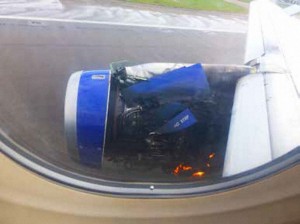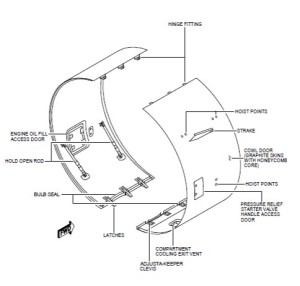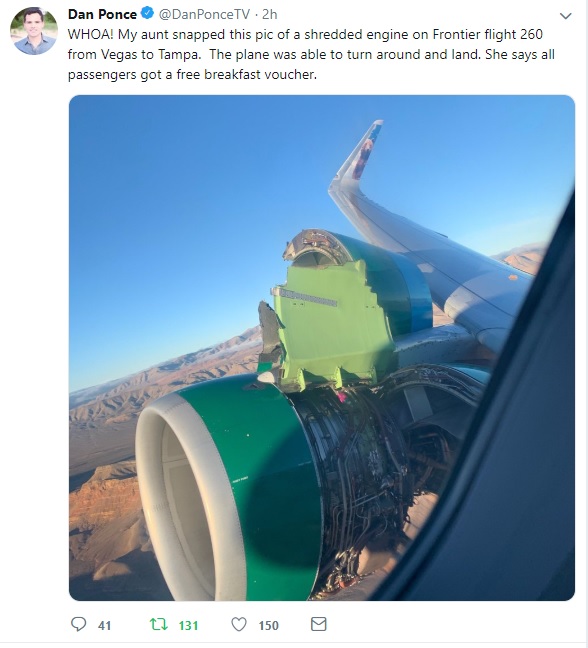A319 Double Cowling Loss and Fire – AAIB Safety Recommendation Update
The UK Air Accidents Investigation Branch (AAIB) has issued an update on responses to their safety recommendations from their investigation into British Airways Airbus A319 G-EUOE. G-EUOE, powered by IAE V2500s, lost both engine fan cowlings and suffered an associated fire on take-off from London Heathrow on 24 May 2013 after cowlings were left unlatched after an ‘aircraft swap error’ during maintenance.
We have discussed that accident report and the causal factors in depth: A319 Double Cowling Loss and Fire – AAIB Report
The AAIB had raised 6 recommendations:
Safety Recommendation 2013-011
It is recommended that Airbus formally notifies operators of A320-family aircraft of the fan cowl door loss event on A319 G-EUOE on 24 May 2013, and reiterates the importance of verifying that the fan cowl doors are latched prior to flight by visually checking the position of the latches.
This resulted in in communication by Airbus to all operators.
AAIB Assessment – Adequate – Closed
Safety Recommendation 2015-001
It is recommended that the European Aviation Safety Agency publishes amended Acceptable Means of Compliance and Guidance Material in Part 145.A.47(b) of European Commission Regulation (EC) No 2042/2003, containing requirements for the implementation of an effective fatigue risk management system within approved maintenance organisations.
EASA has responded:
The Agency is working on Rulemaking Task RMT.0251 (MDM.055) which is intended to introduce Safety Management (SMS) requirements for Part-145 organisations with one of the most important elements being the identification and mitigation of risks one of which is fatigue.
The envisaged timeline for this task is to issue an NPA in 2017, with a final Opinion for 2018.
AAIB Assessment – Partially Adequate – Open
Aerossurance has previously written: Maintenance Personnel Fatigue
Safety Recommendation 2015-002
It is recommended that the European Aviation Safety Agency requires Airbus to modify A320-family aircraft to incorporate a reliable means of warning when the fan cowl doors are unlatched.
EASA responded last October:
Airbus has developed a warning flag, as a design solution for retrofit, that will be more obvious to maintenance crews and pilots to indicate when the fan cowl doors are not properly closed. This flag solution will be available for retrofit for the majority of single aisle fleet in service. An EASA airworthiness directive is planned before the end of 2015 to mandate the implementation of this design change.
AAIB Assessment – Partially Adequate – Open
Safety Recommendation 2015-002
It is recommended that the European Aviation Safety Agency amends Certification Specification 25.901(c), Acceptable Means of Compliance (AMC) 25.901(c) and AMC 25.1193, to include fan cowl doors in the System Safety Assessment for the engine installation and requires compliance with these amended requirements during the certification of modifications to existing products and the initial certification of new designs.
EASA responded:
Based on the lessons learnt from in-service events, the Agency introduced, in 2013, a new Certification Review Item (CRI) providing Special Conditions (SC) for the retention of engine cowls.
The SC requires a cowling design that minimizes any inflight opening or loss of cowling. It also provides some requirements for the retention system of each openable or removable cowling:
Keep the cowling closed and secured under the operational loads and after improper fastening of any single latching, locking, or other retention device, or the failure of single latch or hinge;
Have readily accessible means of closing and securing the cowling that do not require excessive force or manual dexterity; and
Have a reliable means for effectively verifying that the cowling is secured prior to each take-off.
This Special Condition has been applied since 2013, on several large aeroplane certification projects where the design of the cowling and its installation have similarities with the aeroplanes subject to the in-service events of engine cowl separation.
The Agency plans an amendment of CS-25 to introduce such new provisions aiming at better protecting against the risk of engine cowls separation.
AAIB Assessment – Partially Adequate – Open
Safety Recommendation 2015-004
It is recommended that British Airways Plc reviews, and amends as appropriate, its pilot and cabin crew training, policies and procedures regarding in-flight damage assessments and reporting by cabin crew in light of the lessons learned from the G-EUOE fan cowl door loss event.
BA have responded that they have made (an unspecified) change to their Operations Manual Part A.
AAIB Assessment – Adequate – Closed
Safety Recommendation 2015-005
It is recommended that British Airways Plc reviews its evacuation procedures and training to take account of the potential risks of leaving engines running during on-ground emergencies.
BA responded:
…the action remains open as a result of a recommendation in the British Airways investigation into the evacuation of the 777-200 [G-VIIO] in Las Vegas in September 2015. British Airways feels it appropriate to conclude the work on the 777-200 recommendation and apply the learnings from both events as a single action.
AAIB Assessment – Partially Adequate – Open
Airbus has published guidance on preventing leaving cowls unlatched.
UPDATE 28 March 2016: EASA issue AD 2016-0053 on V2500 powered A320s for a Fan Cowl Door Latch with Key and Flag Modification.
UPDATE 27 May 2016: The three EASA responses are also included in their 2015 Annual Safety Recommendations Review.
UPDATE 21 July 2016: The AAIB has issued a further update.
UPDATE 16 December 2016: EASA issue AD 2016-0257 on CFMI CFM56 powered A320s for a Fan Cowl Door Latch with Key and Flag Modification.
Aerossurance has also previously written about a number of human factors / continuing airworthiness issues including:
- Professor James Reason’s 12 Principles of Error Management
- How To Develop Your Organisation’s Safety Culture
- Maintenance Human Factors: The Next Generation
- Aircraft Maintenance: Going for Gold?
UPDATE 12 September 2016: Uncontained CFM56-7 Failure: Southwest B737-700 27 August 2016
UPDATE 11 December 2016: ANSV Report on EasyJet A320 Cowling Loss: Maintenance Human Factors
UPDATE 16 February 2017: Aerossurance is delighted to be sponsoring an RAeS HFG:E conference at Cranfield University on 9 May 2017, on the topic of Staying Alert: Managing Fatigue in Maintenance. This event will feature presentations and interactive workshop sessions.
UPDATE 27 August 2017: We look at the Singapore Transport Safety Investigation Bureau (TSIB) into the 16 October 2015 Tiger A320 Fan Cowl Door Loss & Human Factors
UPDATE 4 December 2017: United Airways Suffers from ED (Error Dysfunction). The US airline shows a strange grasp of human factors principles and argues AGAINST a human centred design change intended to address a long running series of maintenance errors.
UPDATE 24 June 2018: B1900D Emergency Landing: Maintenance Standards & Practices The TSB report posses many questions on the management and oversight of aircraft maintenance, competency and maintenance standards & practices after this serious incident. We look at opportunities for forward thinking MROs to improve their maintenance standards and practices.
UPDATE 25 August 2018: Crossed Cables: Colgan Air B1900D N240CJ Maintenance Error On 26 August 2003 a B1900D crashed on take off after errors during flying control maintenance. We look at the maintenance human factor safety lessons from this and another B1900 accident that year.
UPDATE 8 November 2018: a Vueling A320-200, EC-MDZ, lost the cowls from its left hand V2527 on take off from Bilbao. Debris became stuck in the left main landing gear without affecting retraction or lowering. Debris also punctured a fuselage fairing (images).
UPDATE 5 September 2020: The Spanish air accident investigators, the CIAIAC, have issued their report on the 25 October 2018 loss of cowls from the V2500 powered Vueling A320 EC-MDZ. The cowl release also resulted in damage to cabling and sensors on the main landing gear leg. The causes are similar to the previous events. EASA AD 2016-53 for the fan cowl pin and flag had not been implemented on EC-MDZ at that time (compliance was due by 28 March 2019), although it was planned for November 2018. The Vueling fleet was fully complaint 2.5 months before the deadline and CIAIAC determined that this AD “significantly reduces the risk of improperly latched cowls in the future.
Aerossurance is pleased to be supporting the annual Chartered Institute of Ergonomics & Human Factors’ (CIEHF) Human Factors in Aviation Safety Conference for the third year running. We will be presenting for the second year running too. This year the conference takes place 13 to 14 November 2017 at the Hilton London Gatwick Airport, UK with the theme: How do we improve human performance in today’s aviation business?
Aerossurance is pleased to be both sponsoring and presenting at a Royal Aeronautical Society (RAeS) Human Factors Group: Engineering seminar Maintenance Error: Are we learning? to be held on 9 May 2019 at Cranfield University.






Recent Comments